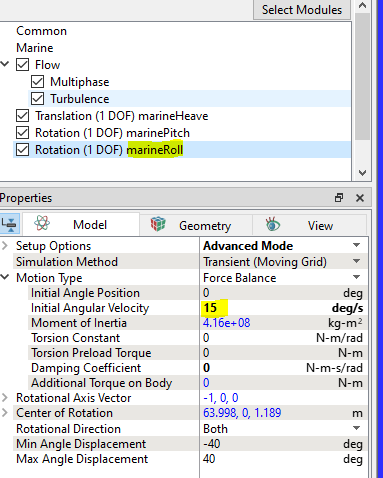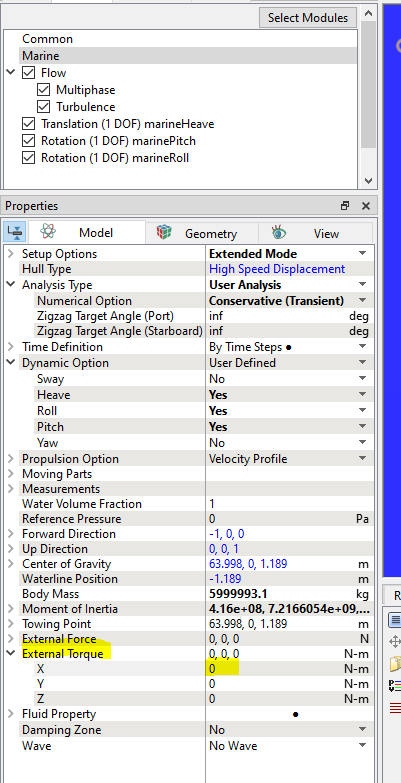If you are simulating roll damping with forward speed, you will need to first run the simulation without roll until the simulation reaches a steady state. If you are simulating roll damping at zero speed, you can skip this step and go right to the next step.

3. Next you must remove all of the numerical damping so that it does not affect the dynamic behavior. Set all of the numerical damping to zero by selecting each of the dynamics modules and setting the corresponding damping coefficient to zero as shown below for marinePitch (do same for marineHeave and marineRoll). Then save this simulation with a new name.


(a) In the first approach, you would load the results from the simulation without roll as the starting point. Then set the initial roll velocity to the desired value such as 15 deg/sec as shown earlier. To make this approach work, you must choose the simulation option "Start from Solution" before clicking the Start button. This sets the simulation time back to zero so that the entered "Initial Angular Velocity" is applied. If you just did a Continuation Run here there would not be any roll velocity applied. After choosing this option click Start to run the roll decay simulation.

(b) In the second approach, you load the results from the no-roll simulation, but you choose "Continuation Run" as the starting condition. In this approach instead of an initial roll velocity you will apply an external roll torque to the model for a specified amount of time. To do this add an expression for the External Torque option in the marine module as shown below. This would be an "X" torque and it would only be applied for a few timesteps before turning it back to zero. In this example the X torque expression might be defined in the Expression Editor as something like:
xTorque = time <= startTime + deltaTime ? rollTorque : 0
where startTime is the beginning time of the continuation run, deltaTime is the amount of time in seconds you want to apply the external torque, and rollTorque is the magnitude of the roll torque in N-m in this case. Click Start to run the roll decay simulation.

(c) When performing a roll decay with forward speed for a resistance simulation (as opposed to a self-propelled simulation), you will need to manually set the forward speed because the "surge" degree-of-freedom is not a part of the simulation. Instead the vessel forward velocity was prescribed. To set the forward speed, expand the "Propulsion Option" in the Marine module properties, and set the "Velocity Profile" and "Projected Max Velocity" speeds to match the prescribed velocity from the resistance simulation with no roll, as shown below.

Was this article helpful?
That’s Great!
Thank you for your feedback
Sorry! We couldn't be helpful
Thank you for your feedback
Feedback sent
We appreciate your effort and will try to fix the article